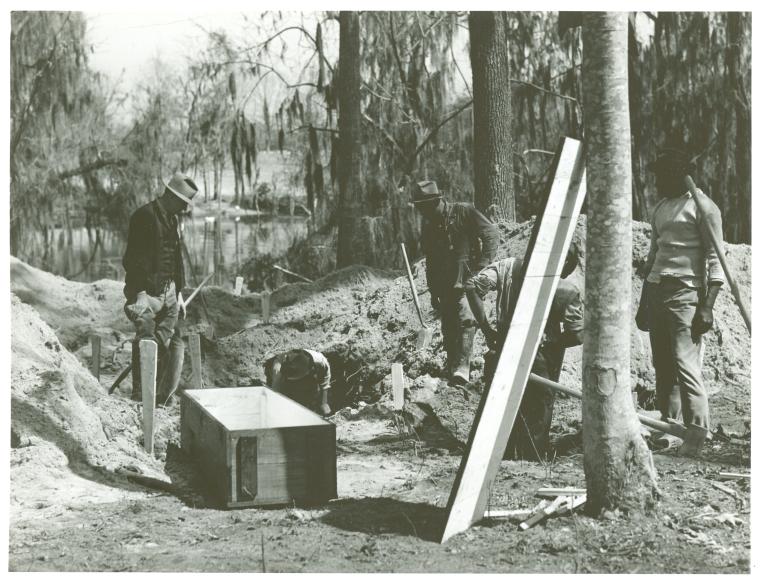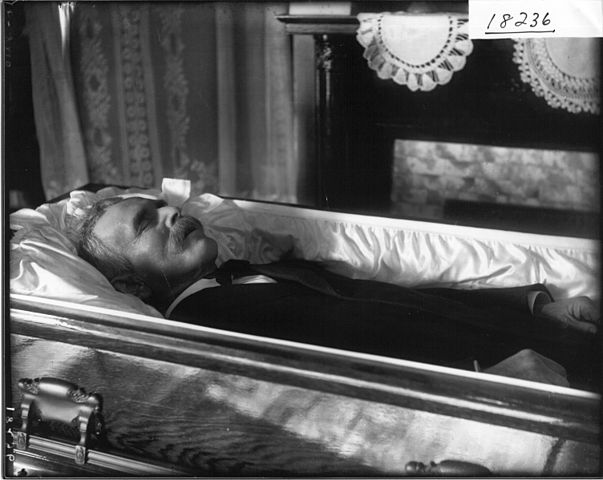
Times were tough in the early twentieth century and people felt a strong need to protect their deceased loved ones with the very best in burglar-proof coffins and tombs. As it was, a freshly buried corpse was highly likely to be dug up by ghouls who sold the remains to medical colleges.
In the United States alone, in 1903, it was estimated the medical colleges used roughly 40,000 corpses a year in their dissecting rooms. Many of those corpses were acquired through theft. Corpses were also stolen to furnish skeleton displays and sometimes ghouls were merely after the gold teeth and jewelry often found in the coffins of the upper classes.
The rampant grave robbing needed a solution, and for many people the answer to stopping the ghouls was to build coffins that were stronger than bank safes.

How One Man Got Into the Business
A fascinating story about how one man got into the burglar-proof coffin business was published in 1894.
Two young actors lived in New York City. One had a small family fortune to fall back on and the other did not. As it happened, the least wealthy companion passed away and the other man paid for his funeral expenses.
Only a night went by before the man’s grave was robbed and his corpse stolen. The man with the family fortune used his spare cash to try and find his partner’s remains, but it was no use. After blowing through his fortune in pursuit of the ghouls, he realized that he had to do something to regain his money.
After what he had gone through with his companion, it was only logical that he would become interested in inventing a burglar-proof coffin, and from there he started his anti-ghoul business. [1]

Impossible to Open
By 1903, there were more burglar-proof coffins on the market and the inventors were making some wild claims about their impregnable caskets.
One maker invented heavy, steel caskets that were supposedly impossible to open once they were shut. The lids were made to fit over a flange and were said to be seamless. This was reinforced with a rubbery cement.
To make doubly sure that no one could open the casket after it has been closed, ten spring locks caught hold of the lid from the inside.
The only way to get the casket open again would have been with the use of explosives and, as the makers claimed, it was highly unlikely that thieves in the dead of night would attempt to use explosives. To do so would surely wake up the watcher or a nearby neighbor and it would also cause damage to the body, making it unfit for dissection at the medical colleges. [2]
Electrically Guarded and Hermetically Sealed
Russell Sage was a railroad executive and a millionaire. He and his surviving wife were also dead set on not having his body stolen after it had been buried.
Upon his passing in 1906, Sage was placed in a solid mahogany casket, lined with a copper envelope that was hermetically sealed within the wooden casket. As if that was not enough, the casket was then placed inside a four-inch thick steel case that weighed three tons. The lock on the case could only be opened from the inside, although there was no way Sage was going to wake up and open the box after what was done next.
The contraction was lowered into the burial plot and the workers prepared the electrical connections strung from the coffin to an above ground alarm. Any attempt to tamper with the coffin would have set off the alarm, although the underground wiring probably electrified the casket while it was active. According to one report, the widow had sanctioned “extraordinary efforts” to keep the remains of her spouse safe from grave robbers.
After the electric was hooked up, evergreen branches covered the coffin, followed by dirt and a large mound, to make gaining access to the coffin too much of a task for any ghoul pressed for time. [3]

Steel and Cement
While electrical alarms and special locks were all the rage in the burglar-proof coffins of the early 1900s, American Industrialist George Pullman was buried a little less elaborately.
Having passed away in 1897, his family feared that someone might dig him back up and hold his remains for ransom. In order to avoid this common problem among millionaires, Pullman’s casket was placed in a steel tomb which was then encased in cement.
For any would-be grave robbers, this meant that they would have to chisel through the cement and use explosives to open the steel encasement. [4]
The Exploding Vault
Steel, cement, and electric alarms were not the only things used in an effort to stop people from digging up the dead. Explosives were introduced in 1878.
It began with the idea of placing a torpedo above the coffin as a wicked surprised, and end, to anyone who tried to dig up a coffin. The idea then gravitated towards placing explosives in the tomb or vault.
In 1880, a patent was issued for a trapped tomb complete with its own explosives so that if anyone tried to break into the tomb, the vibrations would set off the explosives. The idea was not so much to maim the ghouls, but to kill them outright in an effort to get rid of the undesirables.
There is no record of anyone having ever set off one of these exploding vaults and no record of anyone being buried in one. It was, after all, a deadly idea that could have easily killed innocent bystanders and visiting relatives. [5]


1 thought on “The Burglar Proof Coffin Business”
Comments are closed.